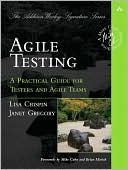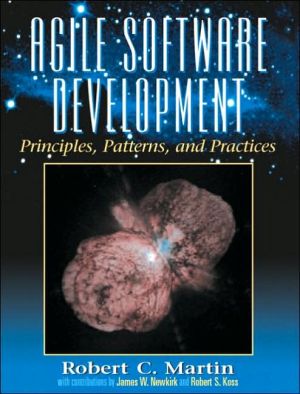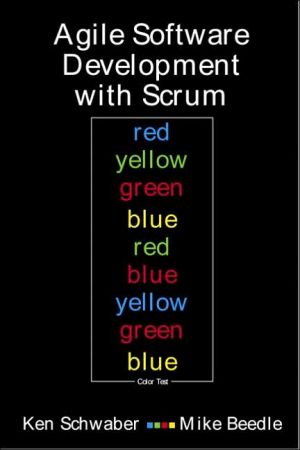Test Driven Development: By Example
Clean code that works--now. This is the seeming contradiction that lies behind much of the pain of programming. Test-driven development replies to this contradiction with a paradox--test the program before you write it.\ A new idea? Not at all. Since the dawn of computing, programmers have been specifying the inputs and outputs before programming precisely. Test-driven development takes this age-old idea, mixes it with modern languages and programming environments, and cooks up a tasty stew...
Search in google:
Presents an approach to writing software that emphasizes automated testing before and during coding. Written for advanced programmers, the book walks through two example projects—multi-currency arithmetic and the xUnit testing framework—and provides patterns for deciding what tests to write and how to write tests using xUnit. The code is written in Java and Python. Annotation c. Book News, Inc., Portland, OR
Clean code that works, in Ron Jeffries' pithy phrase, is the goal of Test-Driven Development (TDD). Clean code that works is a worthwhile goal for a whole bunch of reasons.\ \ It is a predictable way to develop. You know when you are finished, without having to worry about a long bug trail.\ It gives you a chance to learn all of the lessons that the code has to teach you. If you only slap together the first thing you think of, then you never have time to think of a second, better thing.\ It improves the lives of the users of your software.\ It lets your teammates count on you, and you on them.\ It feels good to write it.\ \ But how do we get to clean code that works? Many forces drive us away from clean code, and even from code that works. Without taking too much counsel of our fears, here's what we do: we drive development with automated tests, a style of development called Test-Driven Development (TDD). In Test-Driven Development, we\ \ Write new code only if an automated test has failed\ Eliminate duplication\ \ These are two simple rules, but they generate complex individual and group behavior with technical implications such as the following.\ \ We must design organically, with running code providing feedback between decisions.\ We must write our own tests, because we can't wait 20 times per day for someone else to write a test.\ Our development environment must provide rapid response to small changes.\ Our designs must consist of many highly cohesive, loosely coupled components, just to make testing easy.\ \ The two rules imply an order to the tasks of programming.\ \ Red—Write a little test that doesn't work, and perhaps doesn't even compile at first.\ Green—Make the test work quickly, committing whatever sins necessary in the process.\ Refactor—Eliminate all of the duplication created in merely getting the test to work.\ \ Red/green/refactor—the TDD mantra.\ Assuming for the moment that such a programming style is possible, it further might be possible to dramatically reduce the defect density of code and make the subject of work crystal clear to all involved. If so, then writing only that code which is demanded by failing tests also has social implications.\ \ If the defect density can be reduced enough, then quality assurance (QA) can shift from reactive work to proactive work.\ If the number of nasty surprises can be reduced enough, then project managers can estimate accurately enough to involve real customers in daily development.\ If the topics of technical conversations can be made clear enough, then software engineers can work in minute-by-minute collaboration instead of daily or weekly collaboration.\ Again, if the defect density can be reduced enough, then we can have shippable software with new functionality every day, leading to new business relationships with customers.\ \ So the concept is simple, but what's my motivation? Why would a software engineer take on the additional work of writing automated tests? Why would a software engineer work in tiny little steps when his or her mind is capable of great soaring swoops of design? Courage.\ Courage\ Test-driven development is a way of managing fear during programming. I don't mean fear in a bad way—pow widdle prwogwammew needs a pacifiew-but fear in the legitimate, this-is-a-hard-problem-and-I-can't-see-the-end-from-the-beginning sense. If pain is nature's way of saying "Stop!" then fear is nature's way of saying "Be careful." Being careful is good, but fear has a host of other effects.\ \ Fear makes you tentative.\ Fear makes you want to communicate less.\ Fear makes you shy away from feedback.\ Fear makes you grumpy.\ \ None of these effects are helpful when programming, especially when programming something hard. So the question becomes how we face a difficult situation and,\ \ Instead of being tentative, begin learning concretely as quickly as possible.\ Instead of clamming up, communicate more clearly.\ Instead of avoiding feedback, search out helpful, concrete feedback.\ (You'll have to work on grumpiness on your own.)\ \ Imagine programming as turning a crank to pull a bucket of water from a well. When the bucket is small, a free-spinning crank is fine. When the bucket is big and full of water, you're going to get tired before the bucket is all the way up. You need a ratchet mechanism to enable you to rest between bouts of cranking. The heavier the bucket, the closer the teeth need to be on the ratchet.\ The tests in test-driven development are the teeth of the ratchet. Once we get one test working, we know it is working, now and forever. We are one step closer to having everything working than we were when the test was broken. Now we get the next one working, and the next, and the next. By analogy, the tougher the programming problem, the less ground that each test should cover.\ Readers of my book Extreme Programming Explained will notice a difference in tone between Extreme Programming (XP) and TDD. TDD isn't an absolute the way that XP is. XP says, "Here are things you must be able to do to be prepared to evolve further." TDD is a little fuzzier. TDD is an awareness of the gap between decision and feedback during programming, and techniques to control that gap. "What if I do a paper design for a week, then test-drive the code? Is that TDD?" Sure, it's TDD. You were aware of the gap between decision and feedback, and you controlled the gap deliberately.\ That said, most people who learn TDD find that their programming practice changed for good. Test Infected is the phrase Erich Gamma coined to describe this shift. You might find yourself writing more tests earlier, and working in smaller steps than you ever dreamed would be sensible. On the other hand, some software engineers learn TDD and then revert to their earlier practices, reserving TDD for special occasions when ordinary programming isn't making progress.\ There certainly are programming tasks that can't be driven solely by tests (or at least, not yet). Security software and concurrency, for example, are two topics where TDD is insufficient to mechanically demonstrate that the goals of the software have been met. Although it's true that security relies on essentially defect-free code, it also relies on human judgment about the methods used to secure the software. Subtle concurrency problems can't be reliably duplicated by running the code.\ Once you are finished reading this book, you should be ready to\ \ Start simply\ Write automated tests\ Refactor to add design decisions one at a time\ \ This book is organized in three parts.\ \ Part I, The Money Example—An example of typical model code written using TDD. The example is one I got from Ward Cunningham years ago and have used many times since: multi-currency arithmetic. This example will enable you to learn to write tests before code and grow a design organically.\ Part II, The xUnit Example—An example of testing more complicated logic, including reflection and exceptions, by developing a framework for automated testing. This example also will introduce you to the xUnit architecture that is at the heart of many programmer-oriented testing tools. In the second example, you will learn to work in even smaller steps than in the first example, including the kind of self-referential hoo-ha beloved of computer scientists.\ Part III, Patterns for Test-Driven Development—Included are patterns for deciding what tests to write, how to write tests using xUnit, and a greatest-hits selection of the design patterns and refactorings used in the examples.\ \ I wrote the examples imagining a pair programming session. If you like looking at the map before wandering around, then you may want to go straight to the patterns in Part III and use the examples as illustrations. If you prefer just wandering around and then looking at the map to see where you've been, then try reading through the examples, referring to the patterns when you want more detail about a technique, and using the patterns as a reference. Several reviewers of this book commented they got the most out of the examples when they started up a programming environment, entered the code, and ran the tests as they read.\ A note about the examples. Both of the examples, multi-currency calculation and a testing framework, appear simple. There are (and I have seen) complicated, ugly, messy ways of solving the same problems. I could have chosen one of those complicated, ugly, messy solutions, to give the book an air of "reality." However, my goal, and I hope your goal, is to write clean code that works. Before teeing off on the examples as being too simple, spend 15 seconds imagining a programming world in which all code was this clear and direct, where there were no complicated solutions, only apparently complicated problems begging for careful thought. TDD can help you to lead yourself to exactly that careful thought.\ 0321146530P10172002
PrefaceAcknowledgmentsIntroductionPt. IThe Money Example1Ch. 1Multi-Currency Money3Ch. 2Degenerate Objects11Ch. 3Equality for All15Ch. 4Privacy19Ch. 5Franc-ly Speaking23Ch. 6Equality for All, Redux27Ch. 7Apples and Oranges33Ch. 8Makin' Objects35Ch. 9Times We're Livin' In39Ch. 10Interesting Times45Ch. 11The Root of All Evil51Ch. 12Addition, Finally55Ch. 13Make It61Ch. 14Change67Ch. 15Mixed Currencies73Ch. 16Abstraction, Finally77Ch. 17Money Retrospective81Pt. IIThe xUnit Example89Ch. 18First Steps to xUnit91Ch. 19Set the Table97Ch. 20Cleaning Up After101Ch. 21Counting105Ch. 22Dealing with Failure109Ch. 23How Suite It Is113Ch. 24xUnit Retrospective119Pt. IIIPatterns for Test-Driven Development121Ch. 25Test-Driven Development Patterns123Ch. 26Red Bar Patterns133Ch. 27Testing Patterns143Ch. 28Green Bar Patterns151Ch. 29xUnit Patterns157Ch. 30Design Patterns165Ch. 31Refactoring181Ch. 32Mastering TDD193App. I: Influence Diagrams207App. IIFibonacci211Afterword215Index217
\ From Barnes & NobleThe Barnes & Noble Review\ Every developer wants to write clean code that works -- but somehow, forces always seem to conspire to prevent that. Kent Beck has spent a career on the problem of improving software development: you probably know him best for inventing Extreme Programming (XP). \ XP relies heavily on incremental testing. But this often slips up implementers, for whom constant testing represents a radical change. In Test-Driven Development, Beck brings testing to life, showing exactly how to use it to close the gap between decisions and feedback.\ “TDD” has only two rules. No. 1: Write new code only if you first have a failing automated test. No. 2: Refactor constantly to eliminate duplication. But these rules have complex and subtle implications. You must “design organically,” making decisions based on whether your code passes its test. You must organize your development environment so this is possible. You must write your own tests: you can’t wait for specialists. And your designs must consist of highly cohesive, loosely coupled components: otherwise, micro-scale testing is simply impossible.\ If this still sounds difficult at best, Beck demonstrates TDD through a book-length case study. Its “in-practice” workings will surprise you -- and, we think, convince you. Bill Camarda\ Bill Camarda is a consultant, writer, and web/multimedia content developer. His 15 books include Special Edition Using Word 2000 and Upgrading & Fixing Networks For Dummies®, Second Edition.\ \ \








